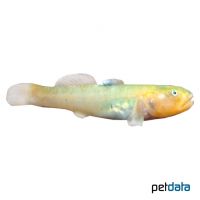Golden Desert Goby (Chlamydogobius eremius 'Gold')
| Golden Desert Goby Chlamydogobius eremius 'Gold' | |
|---|---|
| Name | Golden Desert Goby |
| Name Lat. | Chlamydogobius eremius 'Gold' |
| Synonym | Gobius erimus |
| Family | Gobies |
| Family lat. | Gobiidae |
| Order | Gobies |
| Order lat. | Gobiiformes |
| Origin | Australia |
| Habitat | Streams, ponds |
| Diet | Omnivore |
| pH | 7.0-8.5 |
| Behavior | Peaceful |
| Keeping | Pair, group |
| Care Level | Moderate |
| Reproduction | Cave spawner |
| Breeding | Simple |
| Life Span | 1-2 years |
| Protection | No |
| Metric Units | |
| Size | 5-6 cm |
| Temperature | 20-28 °C |
| Hardness | 5-20 °dH |
| Aquarium | 50 l |
| US Units | |
| Size | 2"-2.4" |
| Temperature | 68-82 °F |
| Hardness | 89-356 ppm |
| Aquarium | 15 gal |
Distribution and habitat
The gold desert goby is a breeding form. The desert gobies are found exclusively (endemically) in the tributaries of Lake Eyre in central Australia. Since the water level of the rivers fluctuates extremely and they dry up partially, the fish often live in isolated pools in shady areas under rocks and plants.
Maintenance
The aquarium should offer numerous hiding places (caves, crevices, tubes) from stones, roots and plants as well as some free sand areas. A substrate of coral sand and fine gravel covered with some foliage (e.g. sea almond leaves), some shaded light, a weak current and slightly alkaline water is ideal
No ammonia, ammonium and nitrite should be detectable in the water, and the nitrate value should not exceed 100 mg/l. To ensure the water quality and oxygen content, a filter and heater adapted to the aquarium size is required, as well as lighting for the species-appropriate day-night rhythm of the animals.
Diet
The food supply consists of live or frozen food, such as cyclops, daphnia, artemia and mosquito larvae or a commercially available, frozen special food mix. In addition, they occasionally require vegetable food (e.g. algae leaves). Dry food is also usually accepted without problems, but should not be the main component of the diet
It is recommended to feed small portions several times a day. Only as much should be fed as is eaten within a few minutes
Behaviour and compatibility
It is recommended to keep them in pairs or better in a group. They occupy small territories around their living and breeding caves, which they defend against conspecifics. Keeping them in groups is only recommended in a larger and richly structured aquarium. They behave very peacefully towards other fish
Basically, only compatible fish species with similar demands on water quality and water temperature may be socialized.
Sex dimorphism
The males have a wider mouth and are more intensely colored than the females. With some experience, the sexes can be distinguished by their genital papilla, which is pointed in the male and short and squat in the female.
Reproduction and breeding
They are cave breeders. After a harmonizing pair is found, the female spawns up to 200 eggs in a cave (clay tube, small flowerpot, etc.) or under a rock or root. The brood is intensively guarded by the male. After 10-17 days the larvae hatch and feed independently
Fry must be fed several times a day with special rearing food, such as slipper lizards and later with Artemia nauplii. Breeding is hardly possible in community tanks, where the fry are easy prey.
Important
In their natural habitat, the vast drainage system of the Eyre Basin, desert gobies are exposed to very harsh conditions with rapid, extreme fluctuations in temperature (5-41 °C), pH (6.5-11.0), and salinity (1-37.5 ‰). They cannot survive in Lake Eyre itself because it is a saline lake. The foliage (e.g., lake almond tree or oak) not only provides cover, but as it rots it encourages the development of microorganisms that provide a valuable secondary food source. The well-being of the fish should be monitored regularly. Temperature should be checked daily, pH, hardness and nitrate levels should be checked at least every 14 days. Regular partial water changes are recommended, even when contaminant levels have not yet reached the upper limit. Sudden changes in water quality should be avoided. Newly introduced fish must be accustomed slowly to the water in the aquarium. Further literature can be found in your pet store.
References
Text: petdata; Image: petdata
Source: BMELV (1998): Tierschutzgutachten - Haltung von Zierfischen (Süßwasser); RIEHL & BAENSCH (2004): Aquarien Atlas Bd. 1, Mergus Verlag; ENGELMANN (2005): Zootierhaltung - Tiere in menschlicher Obhut: Fische, Verlag Harri Deutsch
- Gemäß § 21 Abs. 5 Tierschutzgesetz idgF
